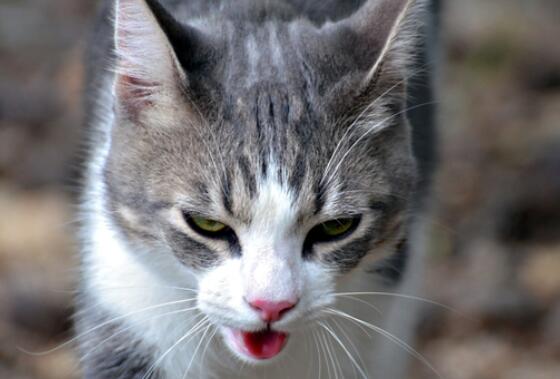Understanding your cat’s natural temperature of the body is very critical especially when it comes to home temperature adjustment. In most cases, your cat is never in your thoughts and you end up adjusting the room temperature to favor yourself only.
You may think the cat will be comfortable once the room temperature is ok for you. However, you are wrong because a cat’s body temperature is different from that of human beings.
Cat’s body temperature is quite higher in some degrees. Although cats are capable of self-adjusting their body temperatures following seasons, you are supposed to step in and make it easier for them.
When it comes to extreme temperatures- too cold or too hot, make sure you pay close attention to your cat. Always make sure your cat is acting normal and healthy.
Cats love heat and as the owner, you need to ensure no temperature condition is threatening its life.
In this article we are going to tackle ideal temperatures for cats, adaptability of cats to temperatures, heatstroke’s on cats, and at-home remedies, and how to ensure your cat is comfy, cool, and happy.
Table of Contents
What is Ideal Temperature for Cats?

To ensure your cat is always comfortable and happy all years, you need to know its ideal body temperature. This will help you to care for them more, as you will be knowing what to do at different seasons.
Compared to human body temperatures which are about 37 degrees Celsius, cats normal temperatures usually range from 37.5 to 39.1 degrees Celsius. Since cat’s core temperatures are quite higher they are capable to withstand external temperatures that are slightly higher than a human can tolerate.
Cats are also able to utilize their body processes to regulate their body temperatures. Their self-sufficient capability to temperature regulation helps them to cope with extreme temperature seasons.
Therefore, it’s necessary to be aware of the cat’s normal or ideal temperature to avoid causing harsh environments when you adjust home temperatures.
Every time temperatures fluctuate take time to check on your cat and note its reactions. You need to take control of a cat’s environment, check how hot is too hot for it depending on whether your cat is hairy or shorthaired.
Longhaired cats are capable of tolerating low temperatures compared to others because their coating is thicker thus warmer. When you let your cat overheat it will have difficulties in breathing and sometimes could cause heatstroke.
Cat’s Adaptability to Temperature Depends on:
Unlike human beings, cats are capable of self-adjusting towards body temperatures changes faster. Their normal temperatures are higher and for them to be comfy in all seasons, their adaptability depends on the following:
– Age:
The age of your cat affects its adaptability to temperatures.

Kittens lack body heat-retaining capacity and in most cases, they end up suffering hypothermia.
When environmental temperatures are normal young cats require higher environmental temperatures than adult cats. Therefore, the older the cat the more heat it may require as they tend to suffer from stiff joints and bone pains, or other chronic illnesses.
If you have kittens or old cats you need to check them closely because they require higher heat levels.
– Breed:
Cat breeds vary from being long-haired such as Siberian cat, Balinese cat, or Main coon cat; to being shorthaired ones like Burmese. Shorthaired breeds’ body temperatures range between 100 to 102.5 degrees Fahrenheit. The long-haired breed has temperatures that are higher due to thick coating giving them warmth. They can better withstand cold temperatures as they are wholly covered to paws.
Unlike shorthaired cats, they are uncomfortable when environmental temperatures are higher.
– Health:
When your cat is in good health it got the energy to adjust body temperatures to meet the external temperatures. In case your cat has some infections or any kind of sickness you are supposed to ensure you provide a better environment, warmer than normal.
For instance, you can provide your cat with a heated blanket or bed. This will make them comfortable as they are weak to adjust to conditions at the time.
Cats are known to tolerate warmer temperatures than humans however when having thyroid conditions your cat will tend to avoid high heat.
– Size:
The cat’s size affects its body heat retention capacity.
When your cat is smaller in size its ability to keep body heat is low. When the cat is slim it requires more heat to be comfy due to its low body fat possession.
In this case, you can provide a heated blanket. Due to the effect of surface area to volume ratio, big and overweight cats are capable of handling cold temperatures easily and better.
Is Summer Heat a Problem for Cats?
Cats are well known for tending to withstand high heat than any other pet or human being. In that case, most people think that summer is no problem for cats cause they originate closely as desert animals.
However, in reality, cats do suffer from heatstroke or overheating, and hyperthermia.
These heat-related cat issues are not very common, because cats are smart when it comes to keeping themselves cool.
Summer heat affects cats and in extreme cases causes health problems.
To beat the summer heat or to keep cool and comfy cats do the things below, wherein in some cases, you need to chip in and assist your pet.
– Energy conservation:
Cats do conserve their energy during warm periods. They tend to be inactive or less, enjoy longer sleeps during the period.
In these ways, they can lower their core temperature and avoid overheating. Your cat will spend time sleeping in cooler regions without direct sunlight to reserve their energy for cooler periods.
– Drinking more water:
Due to high summer heat, cats get too thirsty just like human beings.
During these seasons ensure your cat gets access to clean and cool water. When the condition is extreme you can add ice cubes to your pet’s water as a way of keeping it cooler.
– Seeking out cooler surfaces:
You will find your cat looking for or sleeping on cooler areas such as cemented or tiled floors, kitchen or bathroom floors. This is a way of letting the excess heat be conducted from their body.
During summer periods ensure your cat got access to cooler areas out of direct sunlight.
– Fur coating:
Cats highly benefit from the fur or hairy covering. This fur controls their body temperatures due to its insulating properties during hot weather. In summer make sure your cat’s fur is well brushed and no undercoating.
– Since cats don’t sweat they do groom themselves more in hot weather.
Their body cools as their saliva evaporates from their body fur.
Heat Stroke on Cats
1. What is Heat Stroke?
Heatstroke is a result of increased body temperatures and the body’s inability to control temperatures.
Extreme conditions of overheating can lead to some cat’s body organs failure or complete shutdown. Heatstroke is a very severer incidence of hyperthermia. Your cat can be in danger of suffering from overheating in case of high environmental temperatures, exercise, or anxiety.
Cats are prone to overheating as panting acts as their main way of body temperature regulation.
When your cat is in an area that is poorly ventilated, lacks access to cool water, and is in direct sunlight, it’s highly susceptible to heatstroke.
Therefore, heatstroke is unmanaged heat stress exceeding a cat’s normal temperatures or escalated hyperthermia. This condition is fatal and requires immediate professional attention once suspected. When your cat is suffering from heatstroke you will see the following signs:
- Body temperatures exceed 104 degrees Fahrenheit.
- Disorientation or having restless behavior.
- Vomiting and diarrhea.
2. Causes of Hyperthermia.
Hyperthermia occurs when a cat’s heat exceeds its normal body temperature. When your cat is exposed to extreme environmental heat such as direct sunlight it may develop hyperthermia condition.
Although cats are highly attracted to the warm environment, sometimes their body may fail to self-regulate to extreme temperatures. Other causes of hyperthermia include;
- Lack of access to shade; when your cat is faced with an inability to escape the heat from direct sunlight. It’s at risk of overheating.
- Water; failure to ensure your cat gets access to clean and cool water. In extreme summer conditions provide cooler water by adding ice cubes.
- Chronic illness and overweight.
- Excessive anxiety and exercise
- Excessive cooling.
3. Symptoms of Hyperthermia
Hyperthermia got several symptoms some includes;
- Excessive panting and sweaty paws.
- Restless behavior
- Excessive verbalizations
- Unexplained irritability
- Higher heartbeat rate
4. At-home Remedies
You are supposed to attend to your cat immediately you spot any sign of hyperthermia. Leaving this condition to elevate might lead to more fatal heatstroke. When your cat’s body temperature is about 104 degrees Fahrenheit follow these cooling processes stepwise before it’s too late.
- Pet your cat using a clean wet cloth.
- Leave your cat to sleep on cold surfaces like cemented floors for their excess heat to be conducted away.
- Ensure you give it fresh cold water to drink. Add ice cubes into the water to make it cooler.
- Adjust your room temperature; you can use a fan or putting the lower setting of your house air conditioning.
- You can even bathe your cat to lower body heat immediately.
How to Check Temperature in Cats?
Checking on a cat’s temperature is critical in monitoring its heat to avoid extreme cases that would cause hyperthermia or heat stroke. You can apply several ways to determine the cat’s temperature;
1. Using a thermometer;
It’s not easier to take the temperature of a cat with rising temperature as it’s always uncomfortable and restless. To manage to do so follow this procedure;
– Wrap your cat with a blanket or use help from your friend to overcome its aggressive behavior.
– To get your cat’s temperatures to apply enough amount of lubricant then use a rectal thermometer.
– Insert thermometer slowly into the cat’s anus.
– To achieve the correct reading let it stay for some minutes.
– Lastly, remove it gently and record the temperature reading, clean your thermometer and store it.
2. You can also take the cat’s ear temperature.
In this case, always use a thermometer made for cats’ ears. Their arm can reach a cat’s ear canal. With the assistance of a friend, make sure you hold its body, paws, and held it firmly on the surface to avoid movement.
Place your thermometer deep into the ear canal. To know readings are taken follow instructions provided by the manufacturer. Record the reading and clean the thermometer with rubbing alcohol or soapy water.
3. In case you don’t have a thermometer you can use manual checks to identify a cat’s heat stress.
The following steps will be of great assistance;
– Check for nose moisture: your cat’s nose dryness maybe as a result of overheating or dehydration. To distinguish between the two, slowly with fur uplifted press cats back, immediate return to normal indicates overheating rather than dehydration.
– Check body temperatures; unusual body temperatures indicate your cat is overheating.
– Check ear temperature; in all conditions, a cat’s ears temperature is always warm. In case of overheating the temperature is higher and distinguishable.
How to Keep Cats Comfortable and Cool?
Although extreme cases of heat stress occur during summer periods, it’s necessary to ensure your cat is comfy and cool every single day. To prevent cases of hyperthermia and heat stroke do the following;
– Drinking water.
Always ensure your cat gets access to fresh, clean, and cool water to drink. You can add a few ice cubes to this drinking water during summer days or any hotter days for faster body heat cooling.
– Resting area.
Make sure your cat’s resting space is cool. Elevate the cat’s bed for proper air circulation.
– Playing time.
Always take control of your cat playing time outside. Ensure it doesn’t spend a long time enjoying outdoor sunshine to prevent overheating.
– Environment.
You need to ensure the cat is in cool surroundings. During hot or humid days always adjust the air-conditioning system of your house. You can use a fan in that case.
Conclusion
Cats’ body temperature normally ranges between 37.5 to 39.1 degrees Celsius. Although cats are known to be attracted to heat, extreme temperatures make their body fail to self-regulate. This might cause hyperthermia and heatstroke. It’s necessary to keep the cat’s temperature in check to ensure it’s comfortable and cool every day.

